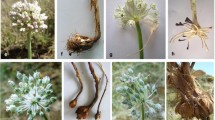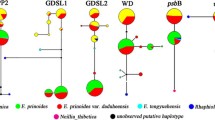Summary
Tragopogon ×mirabilis Rouy is described as a diploid hybrid between T. porrifolius and T. pratensis. A population of T. ×mirabilis from Central Bohemia, Czech Republic, was recently investigated and, unlike previous reports of T. ×mirabilis, was found to be highly fertile. This fertile diploid hybrid population was considered to represent an alternative evolutionary pathway to polyploidy in Tragopogon. To determine the parentage of the plants from Bohemia, we investigated 12 samples of T. ×mirabilis with ITS, ETS, LFY and plastid (rpL16 gene, intron 1, tRNA-Leu (trnL) gene, intron, trnL-trnF intergenic spacer, psbA-trnH intergenic spacer, and trnG-trnT intergenic spacer) sequence data. None of the Bohemian plants have sequences that are consistent with a hybrid origin between T. porrifolius (incl. T. australis) and T. pratensis. Our data suggest that this fertile population of “T. ×mirabilis” may represent an unrecognised diploid species from the Angustissimi clade sensu Mavrodiev et al. (Int. J. Pl. Sci. 164: 1 – 19, 2005), a clade with a centre of distribution in the Caucasus, and hybrids of this unknown species with T. orientalis or T. hayekii (= T. orientalis L. var. hayekii Soó), a species closely related to T. pratensis and native to Bohemia. The Bohemian population of “Tragopogon ×mirabilis” clearly requires more investigation, but based on our data it does not appear to represent T. porrifolius × T. pratensis.



Similar content being viewed by others
References
Andreasen, K. & Baldwin, B. G. (2003). Nuclear ribosomal DNA sequence polymorphism and hybridization in checker mallows (Sidalcea, Malvaceae). Molec. Phylogenet. Evol. 29: 563 – 581.
Bailey, C. D., Carr, T. G., Harris, S. A. & Hughes, C. E. (2003). Characterization of angiosperm nrDNA polymorphism, paralogy, and pseudogenes. Molec. Phylogenet. Evol. 29: 435 – 455.
Borisova, A. G. (1964). Tragopogon. In: B. K. Shishkin (ed.), Flora of the U.S.S.R. XXIX: 115 – 196. Izdatel’stvo Akademii Nauk. SSSR, Moskva-Leningrad. [in Russian].
Buckler, E. S., Ippolito, A. & Holtsford, T. P. (1997). The evolution of ribosomal DNA: divergent paralogues and phylogenetic implications. Genetics 145: 821 – 832
Buggs, R. J. A., Doust. A. N., Tate, J. A., Koh, J., Soltis, K., Feltus, F. A., Paterson, A. H., Soltis, P. S. & Soltis, D. E. (2009). Gene loss and silencing in Tragopogon miscellus (Asteraceae): comparison of natural and synthetic allotetraploids. Heredity 103: 73 – 81.
Campbell, C. S., Wojciechowski, M. F., Baldwin, B. G., Alice, L. A. & Donoghue, M. J. (1997). Persistent nuclear ribosomal DNA sequence polymorphism in the Amelanchier agamic complex (Rosaceae). Molec. Biol. Evol. 14: 81 – 90.
Fahselt, D., Ownbey, M. & Borton, M. (1976). Seed fertility in Tragopogon hybrids (Compositae). Amer. J. Bot. 63: 1109 – 1118.
Farwell, O. A. (1930). Botanical cleanings in Michigan, VI. Amer. Midl. Naturalist 12: 132 – 134.
Grob, G. B. J., Gravendeel, B. & Eurlings, M. C. M. (2004). Potential phylogenetic utility of the nuclear FLORICAULA/LEAFY second intron: comparison with three chloroplast DNA regions in Amorphophallus (Araceae). Molec. Phylogenet. Evol. 30: 13 – 23.
Howarth, D. G. & Baum, D. A. (2005). Genealogical evidence of homoploid hybrid speciation in an adaptive radiation of Scaevola (Goodeniaceae) in the Hawaiian Islands. Evolution 59: 948 – 961.
Koh, J., Soltis, P. S. & Soltis, D. E. (2010). Homeolog loss and expression changes in natural populations of the recently and repeatedly formed allotetraploid Tragopogon mirus (Asteraceae). BMC Genomics 11: 2010 February 8.
Kovarik, A., Pires, J. C., Leitch, A. R., Lim, K. Y., Sherwood, A. M., Matyasek, R., Rocca, J., Soltis, D. E. & Soltis, P. S. (2005). Rapid concerted evolution of nuclear ribosomal DNA in two Tragopogon allopolyploids of recent and recurrent origin. Genetics 169: 931 – 944.
Krahulec, F., Kaplan, Z. & Novák, J. (2005). Tragopogon porrifolius × T. pratensis: the present state of an old hybrid population in Central Bohemia, the Czech Republic. Preslia 77: 297 – 306.
Mack, R. N. & Erneberg, M. (2002). The United States naturalized flora: largely the product of deliberate introductions. Ann. Missouri Bot. Gard. 89: 176 – 189.
Mavrodiev, E. V., Tancing, M., Sherwood, A. M., Gitzendanner, M. A., Rocca, J., Soltis, P. S. & Soltis, D. E. (2005). Phylogenetic relationships in Tragopogon L. (Asteraceae) based on ITS and ETS sequence data. Int. J. Pl. Sci. 164: 1 – 19.
____, Soltis, P. S., Gitzendanner, M. A., Baldini, R. M. & Soltis D. E. (2007). Polyphyly of Tragopogon porrifolius (Asteraceae), a Eurasian native with intercontinental disjuncts. Int. J. Pl. Sci. 168: 889 – 904.
____, Albach, D. C. & Speranza, P. (2008a). A new polyploid species of the genus Tragopogon (Asteraceae, Cichorieae) from Russia. Novon 18: 229 – 232.
____, Soltis, P. S. & Soltis, D. E. (2008b). Putative parentage of six Old World polyploids in Tragopogon L. (Asteraceae: Scorzonerinae) based on ITS, ETS, and plastid sequence data. Taxon 57: 1215 – 1232.
____, Gitzendanner, M. A., Calaminus, A. K., Baldini, R. M., Soltis, P. S. & Soltis, D. E. (2013). Molecular phylogeny of Tragopogon L. (Asteraceae) based on seven nuclear loci (Adh, GapC, LFY, AP3, PI, ITS, and ETS). Webbia: in press.
Novak, S., Soltis, D. E. & Soltis, P. S. (1991). Ownbey’s Tragopogons: 40 years later. Amer. J. Bot. 78: 1586 – 1600.
Ownbey, M. (1950). Natural hybridization and amphiploidy in the genus Tragopogon. Amer. J. Bot. 37: 487 – 499.
____ & McCollum, G. D. (1954). The chromosomes of Tragopogon. Rhodora 56: 7 – 21.
Richardson, I. B. K. (1976). Tragopogon. In: T. G. Tutin, V. H. Heywood, N. A. Burges, D. M. Moore, D. H. Valentine, S. M. Walters & D. A. Webb (eds), Flora Europaea 4: 322 – 326. Cambridge University. Press, Cambridge.
Rouy, G. (1890). Remarques sur la synonymie de quelques plantes occidentales. Bull. Soc. Bot. France 37 (session extraordinaire a la Rochelle): 14 – 20.
Soltis, D. E. (1981). Variation in hybrid fertility among the disjunct populations and species of Sullivantia (Saxifragaceae). Canad. J. Bot. 59: 1174 – 1180.
Swofford, D. L. (2002). PAUP*: phylogenetic analysis using parsimony (*and other methods), version 4.10b. Sinauer, Sunderland, MA.
Tate, J. A., Ni, Z., Scheen, A. C., Koh, J., Gilbert, C. A., Lefkowitz, D., Chen, Z. J., Soltis, P. S. & Soltis, D. E. (2006). Evolution and expression of homeologous loci in Tragopogon miscellus (Asteraceae), a recent and reciprocally formed allopolyploid. Genetics 173: 1599 – 1611.
____, Prashant, J., Soltis, K. A., Soltis, P. S. & Soltis, D. E. (2009). On the road to diploidization? Homoeolog loss in independently formed populations of the allopolyploid Tragopogon miscellus (Asteraceae). BMC Plant Biol. 9: 27 June 2009.
Wilson, D. (1983). Karyotypes of Tragopogon (Compositae: Lactuceae). Brittonia 35: 341 – 350.
Acknowledgements
We thank Dr Alex A. Sennikov (University of Helsinki, Finland) for providing samples of leaf material. This work was support by US NSF grants MCB-0346437 and DEB-0614421.
Author information
Authors and Affiliations
Corresponding author
Appendix 1
Appendix 1
Voucher data and the GenBank accession numbers for individuals sequenced in this study.
Tragopogon cretaceus S. A. Nikitin: European Russia, det. Tzvelev N. N. (MW). 5.8S rRNA gene, internal transcribed spacer 1 (ITS 1) and 2 (ITS 2): HQ456271; external transcribed spacer: HQ456289.
T. elatior Steven: Laspi, a mare ad altitudi 200 hexap., Taur. merid., Compere (H). Internal transcribed spacer 1 (ITS1): HQ456272.
T. ×mirabilis Rouy: Roudnice nad Labem, 14 – 15E, 50 – 25 N, alt. c. 180 – 190 m. 15 Oct. 2005, Jan Novak. Field collections. 5.8S rRNA gene, internal transcribed spacer 1 (ITS 1) and 2 (ITS 2): HQ456256–68; LEAFY (LFY) gene, intron 2: HQ456290–91; psbA-trnH intergenic spacer, plastid: HQ456292–93; rpL16 gene, intron 1: HQ456294–95; trnG-trnT intergenic spacer: HQ456296–97; trnL-trnF intergenic spacer: HQ456298–99; tRNA-Leu (trnL) gene, intron: HQ456300–01.
T. porrifolius L.: Slovenia, Botanic Garden, Ljubljana, collection # 1007. 5.8S rRNA gene, internal transcribed spacer 1 (ITS 1) and 2 (ITS 2): HQ456269; external transcribed spacer: HQ456287.
T. pratensis L.: Czech Republic, NW part, Cheb, between villages Uboci and Zandov, 50°02.375'N, 12°33.782'E, altitude 528 m, field collection # 929; cultivated in the garden of the Institute of Botany, Academy of Science of the Czech Republic, Pruhonice, Czech Republic, Nov. 2005, 5.8S rRNA gene, internal transcribed spacer 1 (ITS 1) and 2 (ITS 2): HQ456270; external transcribed spacer: HQ456288.
Rights and permissions
About this article
Cite this article
Mavrodiev, E.V., Krahulec, F., Soltis, D.E. et al. A cryptic taxon rather than a hybrid species of Tragopogon (Asteraceae) from the Czech Republic. Kew Bull 68, 133–141 (2013). https://doi.org/10.1007/s12225-012-9431-z
Accepted:
Published:
Issue Date:
DOI: https://doi.org/10.1007/s12225-012-9431-z




